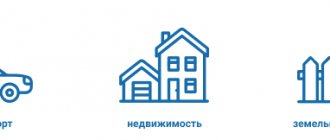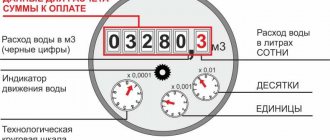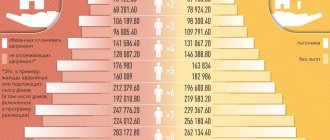Following international experience, since 2013 the Russian authorities have introduced the so-called two-component tariff for hot water - DHW. The calculation of the payment for hot water according to the two-component tariff in the housing and communal services receipt in closed water supply systems is carried out based on the following components:
· the actual volume of cold water used, paid at the standard tariff for cold water;
· the actual amount of heat used to heat cold water. It is paid at a separate rate.
Simply put, the cost of hot water at the tap is determined by the prices of cold water and thermal energy to heat it.
The volume of resource consumed is determined by the hot water meter, and if it is missing, by the generally accepted consumption standard. Payment for water heating in utility bills is calculated according to the standard heat consumption used for heating.
The possibility of applying a two-component tariff for hot water supply is established by the following laws:
·P. 9 tbsp. 32FZ No. 416 dated December 7, 2011 “On water supply and sanitation” – in closed systems;
·P. 5 tbsp. 9FZ No. 190 dated July 27, 2010 “On Heat Supply” – in open water supply systems.
But these laws only determine the possibility and components of such a tariff, and specific provisions are contained in the by-laws.
In particular, the obligation to establish water and heat consumption standards, as well as switch to a two-component tariff from 2021, rests with the regional authorities in paragraph 2 of Government Resolution No. 129 of 02/14/2015. He also makes changes to the Rules for determining standards for the consumption of utility services, approved by Government Decree No. 306 of May 23, 2006, and the Rules for the provision of utility services, approved by Government Decree No. 354 of May 6, 2011.
According to the listed documents, the authorized body is obliged to establish a heat standard for heating water, taking into account:
water supply systems;
· design features of apartment buildings;
· availability of water folding devices;
·sanitary equipment and so on.
The houses do not have a connection to a centralized hot water supply system
RSO Heat Supply from Petropavlovsk-Kamchatsky went to court with a demand to recover from one of the management companies the debt to pay for utility resources consumed for the maintenance of the common property of the owners of the apartment building. The debt and penalties for late payments amounted to almost 220 thousand rubles.
The management authority refused to pay this debt, since 11 of the 19 houses under its management do not have a separate hot water supply system. Residents take hot water from heating radiators. In such houses it is impossible to provide the hot water supply service to the Kyrgyz Republic, and the company does not agree to pay for it.
The management organization provided documents to the court confirming that only eight houses under its management have a centralized hot water supply system. The company did not dispute the debt for the supply of hot water for the maintenance of common property in these apartment buildings. The subject of consideration by courts of all instances was the question of whether the UO should repay the debt for the CD on SOI, which RSO calculated for it in those houses where there is no such system (case No. A24-1044/2020).
The hot water supplier noted in the court of first instance that an inspection of the intra-house networks of the apartment complex showed the absence of leaks. Since residents of houses take water from the heating system and do not return it there, then this is the selection of coolant as hot water from an open heating system for the provision of public hot water services.
The MA believed that such actions - taking water from heating radiators and heated towel rails - are not evidence of the provision of hot water supply services by the Kyrgyz Republic to SOI.
Should RSO make a recalculation if the volume of CD on SOI is negative?
Gcal standard for heating 1 m3 of water
The purpose of introducing a two-component tariff is a gradual transition to world standards, according to which calculations cannot be made for 1 m3 of hot water as the final product of production. This method of calculation is still in use, but by 2022 the cubic meter will be used according to a meter or consumption standard to account for the total volume of water used.
Using cold and hot water
The amount of heat to heat the cube is measured in Gcal (gigacalories). Calorie is the unit required to heat 1 g of water by 1 °C, under natural conditions - at normal atmospheric pressure.
To understand the value of Gcal as a unit of measurement, it is enough to understand that this volume of thermal energy for heating is enough to increase the temperature of a thousand tons of water by one degree.
The calculation of the standard for heating hot water in Gcal is legally stipulated by the “Rules for the accounting of thermal energy and coolant”, published and developed by the Ministry of Fuel and Energy of Russia back in 1995. Cold water consumption is carried out according to the meter, in cubic meters.
Standards for heating in the Tver region
The volume of thermal energy consumption is obtained by multiplying the norm established in the region for heating the cube by the water used by the consumer. Its quantity is determined by the installed meter or by regional standards.
In regions where a system of payment for hot water based on two components has not yet been introduced (for example, in the Chelyabinsk region), in 2022 they must develop a regulatory framework and switch to a generally accepted payment system. Such a measure will lead, albeit not very significant, to an increase in tariffs for hot water supplies.
Standards for heating in the Krasnoyarsk Territory
To prevent this from hitting the population’s pockets, certain measures have been taken in advance:
- In some regions of the federation, the introduction of the system was postponed, but in some places they have already come into effect on July 1, 2021.
- Average coefficients have been established for all regional entities. This is the maximum cost above which you cannot charge for hot water. They can be found in Executive Order No. 1347, dated November 12, 2021.
- There are limits that limit the powers of local governments. They are indicated in the order of the Government of the Russian Federation.
Standards in the Volgograd region
The size of the increase in tariffs for water heating varies. For example, the Government of St. Petersburg did not consider it necessary to use the figure of 6%, which is indicated in the order. 3.5% was considered a sufficient measure, which amounted to 59.45 rubles. Moscow will feel the rise in prices in different ways: Mosenergo will charge 130.27 rubles from the second half of the year. per cubic meter, and other companies - 163.36 rubles. per cube of heated water.
DHW does not have a separate connection to the pipelines of the open heating system of the house
The court of first instance, resolving the dispute between the UO and the RSO, indicated that the possibility of charging for the consumed CR on the SOI depends on the design features of the apartment building.
Hot water supply in accordance with paragraphs. “b” clause 4 of RF PP No. 354 is the supply of hot water supplied through centralized hot water networks and in-house engineering systems to residential and non-residential premises in an apartment building, as well as to premises included in the common property.
By virtue of Part 19.1 of Art. 2 of Federal Law No. 190-FZ of July 27, 2010, an open heat supply or hot water supply system is understood as a technologically connected complex of engineering structures designed for heat supply and hot water supply by extracting hot water from the heating network. At the same time, DHW in open heating systems must have a separate connection to the return and supply pipelines, which makes it possible to regulate and maintain the water temperature.
The court of first instance, when considering case No. A24-1044/2020, indicated that its important circumstances include the presence in the disputed apartment buildings of a separate hot water system connected to the supply and return pipelines of the heating system.
RSO insisted that the apartment buildings are connected to centralized networks: the technical passports of these houses contain information about the presence of bathrooms with hot water supply from the central network. But the management office indicated that in fact there is no connection of houses to hot water supply systems. She provided reports indicating that the in-house hot water supply networks have been inoperative since the moment the apartment buildings were put into operation.
Based on this, the court noted: in the disputed apartment buildings there is no centralized hot water supply, this implies that there is no hot water supply service for the Kyrgyz Republic at the SOI. During the non-heating period, the judge pointed out, residents of the house have no way to get hot water at all. According to the court, the extraction of hot water from the heating system cannot be recognized as evidence of consumption of the communal resource “hot water” in the house during the maintenance of common property.
The court of first instance decided that these facts prove: in 11 houses under the defendant’s management there are no hot water services from the Kyrgyz Republic at SOI, therefore RSO does not have the right to demand payment from the company for it. As a result, the court confirmed that the management organization owes the hot water supplier only 62 thousand rubles for the KR on SOI for eight houses with a centralized hot water system and only 83 rubles in penalties.
When the management authority does not have the right to refuse to pay the Kyrgyz Republic for the waste water disposal system
Calculation of fees for hot water supply in apartment buildings using two-component tariffs
Comments
Methods for calculating the amount of payment for hot water supply are approved in the Rules of the Decree of the Government of the Russian Federation dated May 6, 2011. No. 354 (hereinafter referred to as the Rules).
There are two types of tariffs for hot water supply - single-component tariffs , with a fixed price per 1 cubic meter, as well as two-component tariffs , which have two components - a component for cold water or coolant, and a component for thermal energy .
That is, when using two-component tariffs, the payment amount is calculated based on two components: the price of one cubic meter of cold water, and the price of one gigacalorie of thermal energy, which heats cold water to hot water.
To calculate the amount of payment for hot water supply when establishing two-component tariffs for hot water, separate formulas are used in Appendix No. 2 of the Rules, which are slightly different from the formulas for normal calculations.
It should be noted that tariffs for hot water supply are set by local governments of the constituent entities of the Russian Federation for providers of this service.
In this article we will look at the procedure and examples of calculating the amount of payment for hot water supply provided in a residential building, and for hot water supply provided for general house needs, in an apartment building that has a centralized hot water supply using a two-component tariff in accordance with the provisions of the Rules.
Calculation No. 1 - calculation of fees for hot water supply, in an apartment with an individual meter using a two-component tariff
Calculation No. 2 - calculation of payment for hot water supply in an apartment in the absence of an individual meter; there is no technical possibility of installing such a device using a two-component tariff
Calculation No. 3 - calculation of fees for hot water supply in an apartment in the absence of an individual metering device, but it is technically possible to install such a device using a two-component tariff
Calculation No. 4 - calculation of payment for hot water supply provided for common building needs, in the absence of a common building meter in an apartment building using a two-component tariff
Calculation No. 5 - calculation of payment for hot water supply provided for common house needs, a common house meter in an apartment building is installed using a two-component tariff
Calculation of the amount of payment for hot water supply to an apartment located in an apartment building
No. 1 Calculation of the fee in the presence of an individual meter for hot water using a two-component tariff
The amount of payment for hot water supply in residential/non-residential premises equipped with an individual and (or) common (apartment) hot water meter using a two-component tariff is determined by formula No. 23 :
Formula No. 23
Pi = ViP x Txv + QPi x Tt/e
ViП - volume (quantity) of hot water consumed during the billing period in a residential or non-residential premises, determined according to the readings of an individual or general (apartment) meter.
THW is a component for cold water or coolant , which is an integral part of the tariff for hot water (hot water supply) established in accordance with the legislation of the Russian Federation , that is, the tariff (price) for cold water supply established in your region.
QPi - volume (quantity) of thermal energy used to heat water in order to provide public services for hot water supply for the billing period in the i-th residential or non-residential premises, is calculated as the product of Viп and the approved standard for the consumption of thermal energy used to heat water for provision of public services for hot water supply;
Ht/e is a component for thermal energy , which is an integral part of the tariff for hot water (hot water supply) established in accordance with the legislation of the Russian Federation, that is, the tariff (price) for thermal energy established in your region.
EXAMPLE OF CALCULATING THE AMOUNT OF CHARGES FOR HOT WATER SUPPLY USING FORMULA No. 23
First of all, we determine that this calculation is performed:
» for an apartment located in an apartment building; » the apartment hot water meter installed A two-component tariff for hot water supply is used for calculation .
INITIAL DATA FOR CALCULATION:
The volume of hot water consumed according to the readings of your individual meter for January 2019 was 4 cubic meters (m3) (ViP - in the formula).
The tariff for cold water supply established for your region and service provider is 28.37 rubles. per 1 cubic meter (m3) (Тхв - in the formula).
The standard consumption of thermal energy used to heat water to provide public services for hot water supply is 0.059 Gcal per 1 cubic meter (m3) (the QPi component is in the formula).
Thermal energy tariff established for your region and service provider is RUB 2,468.16. for 1 Gcal (Tt/e - in the formula).
The amount of payment for hot water supply using a two-component tariff for your apartment will be calculated as follows:
First of all, let's calculate the QPi component, that is, the amount of thermal energy consumed to heat 4 m3 of cold water to hot water, according to the readings of an individual meter. To do this, we multiply the volume of hot water consumed according to the readings of an individual meter by the standard thermal energy used for heating.
4 m3 x 0.059 Gcal = 0.236 Gcal
In total, the volume of thermal energy consumed to heat the hot water supply will be 0.236 Gcal.
Now that all the components of the formula are known, let's calculate the size of the board:
4m3 x 28.37 rub. + 0.236 Gcal x 2468.16 rub. = 695.97 rub.
The total fee for hot water supply in your apartment will be 695.97 rubles.
No. 2 Calculation of charges for hot water supply using a two-component tariff in the absence of an individual hot water meter; there is no technical possibility of installing such a device.
Calculation of the amount of payment for hot water supply using a two-component tariff in a residential premises (apartment) that is not equipped with an individual hot water meter, and in the absence of the technical ability to install such a meter, is made according to formula No. 23 of Appendix No. 2 of the Rules.
Formula No. 23
Pi = ViP x Txv + QPi x Tt/e
ViП - volume (quantity) of hot water consumed in a residential premises during the billing period, based on the consumption standard and the number of citizens living in the residential premises.
THW is a component for cold water or coolant , which is an integral part of the tariff for hot water (hot water supply) established in accordance with the legislation of the Russian Federation , that is, the tariff (price) for cold water supply established in your region.
QPi - volume (quantity) of thermal energy used to heat water in order to provide public services for hot water supply for the billing period in the i-th residential or non-residential premises, is calculated as the product of Viп and the approved standard for the consumption of thermal energy used to heat water for provision of public services for hot water supply;
Ht/e is a component for thermal energy , which is an integral part of the tariff for hot water (hot water supply) established in accordance with the legislation of the Russian Federation, that is, the tariff (price) for thermal energy established in your region.
EXAMPLE OF CALCULATING THE AMOUNT OF CHARGES FOR HOT WATER SUPPLY USING FORMULA No. 23
First of all, we determine that this calculation is performed:
» for an apartment located in an apartment building; » the apartment does not have an individual hot water meter installed ; there is no technical ability to install an individual meter; » calculation of the payment for hot water supply is carried out using a two-component tariff
INITIAL DATA FOR CALCULATION:
4 people live in your apartment .
The hot water standard established for your region is 3.2 cubic meters (m3) per person.
The tariff for cold water supply established for your region and service provider is 28.37 rubles. per 1 cubic meter (m3) (Тхв - in the formula).
The standard consumption of thermal energy used to heat water to provide public services for hot water supply is 0.059 Gcal per 1 cubic meter (m3) (the QPi component is in the formula).
Thermal energy tariff established for your region and service provider is RUB 2,468.16. for 1 Gcal (Tt/e - in the formula).
The payment for hot water supply for your apartment will be calculated as follows:
First of all, we will calculate the ViP component for your apartment, that is, the volume of hot water consumed in your apartment based on the consumption standard established for hot water. To do this, you need to multiply the number of citizens living in the apartment by the hot water consumption standard established in your region.
4 people x 3.2 m3 = 12.8 m3
Then, it is necessary to calculate the component of the formula QPi, that is, the volume of thermal energy consumed to heat 12.8 m3 of cold water to hot water, according to the volume of hot water supply calculated according to the standard. To do this, we multiply the volume of hot water supply, previously calculated according to the standard, by the standard of thermal energy used for heating.
12.8 m3 x 0.059 Gcal = 0.7552 Gcal
Now that all the components of the formula are known, let's calculate the size of the board:
12.8 m3 x 28.37 rub. + 0.755 Gcal x 2468.16 rub. = 2227.09 rub.
The total fee for hot water supply in your apartment will be RUB 2,227.09.
No. 3 Calculation of charges for hot water supply using a two-component tariff in the absence of an individual hot water meter, but it is technically possible to install such a meter.
The calculation of the amount of payment for hot water supply in a residential premises (apartment) that is not equipped with an individual hot water meter, but it is technically possible to install such a meter, is made using a two-component tariff according to formula No. 23(1) of Appendix No. 2 of the Rules.
Formula No. 23(1)
Pi = Kpov x ViP x Txv + QPi x Tt/e
ViП - volume (quantity) of hot water consumed in a residential premises during the billing period, based on the consumption standard and the number of citizens living in the residential premises.
THW is a component for cold water or coolant , which is an integral part of the tariff for hot water (hot water supply) established in accordance with the legislation of the Russian Federation , that is, the tariff (price) for cold water supply established in your region.
QPi - volume (quantity) of thermal energy used to heat water in order to provide public services for hot water supply for the billing period in the i-th residential or non-residential premises, is calculated as the product of Viп and the approved standard for the consumption of thermal energy used to heat water for provision of public services for hot water supply;
Ht/e is a component for thermal energy , which is an integral part of the tariff for hot water (hot water supply) established in accordance with the legislation of the Russian Federation, that is, the tariff (price) for thermal energy established in your region.
Kpov - increasing coefficient equal to 1.5 from January 1, 2021.
EXAMPLE OF CALCULATING THE AMOUNT OF CHARGES FOR HOT WATER SUPPLY USING FORMULA No. 23(1)
First of all, we determine that this calculation is performed:
» for an apartment located in an apartment building; » the apartment hot water meter installed it is technically possible to install such a meter . » calculation of the payment for hot water supply is carried out using a two-component tariff
INITIAL DATA FOR CALCULATION:
4 people live in your apartment .
The hot water standard established for your region is 3.2 cubic meters (m3) per person.
The tariff for cold water supply established for your region and service provider is 28.37 rubles. per 1 cubic meter (m3) (Тхв - in the formula).
The standard consumption of thermal energy used to heat water to provide public services for hot water supply is 0.059 Gcal per 1 cubic meter (m3) (the QPi component is in the formula).
Thermal energy tariff established for your region and service provider is RUB 2,468.16.
for 1 Gcal (Tt/e - in the formula). The increasing coefficient is 1.5 (Kpov - in the formula).
The payment for hot water supply for your apartment will be calculated as follows:
First of all, we will calculate the ViP component for your apartment, that is, the volume of hot water consumed in your apartment based on the consumption standard established for hot water. To do this, you need to multiply the number of citizens living in the apartment by the hot water consumption standard established in your region.
4 people x 3.2 m3 = 12.8 m3
Then, it is necessary to calculate the component of the formula QPi, that is, the volume of thermal energy consumed to heat 12.8 m3 of cold water to hot water, according to the volume of hot water supply calculated according to the standard. To do this, we multiply the volume of hot water supply, previously calculated according to the standard, by the standard of thermal energy used for heating.
12.8 m3 x 0.059 Gcal = 0.7552 Gcal
Now that all the components of the formula are known, let's calculate the size of the board:
1.5 x 12.8 m3 x 28.37 rub. + 0.755 Gcal x 2468.16 rub. = 2408.66 rub.
The total fee for hot water supply in your apartment will be RUB 2,408.66.
The procedure for calculating the amount of payment for hot water supply provided for general house needs using a two-component tariff
No. 4 Calculation of the amount of payment for hot water supply provided for common building needs in an apartment building that is not equipped with a common building meter for hot water supply, using a two-component tariff
Calculation of the amount of payment for hot water supply provided for general house needs in an apartment building that is not equipped with a common building meter , using a two-component tariff, is carried out according to formulas No. 15 and No. 24 . Formula No. 15 calculates the volume of hot water, and formula No. 24 calculates the amount to be paid.
Formula No. 15
Nodn - consumption standard for hot water supply, provided for the billing period for general house needs in an apartment building, established in accordance with the Rules for establishing and determining standards for the consumption of utility services, approved by Decree of the Government of the Russian Federation of May 23, 2006 No. 306
Si - total area of residential premises (apartment) or non-residential premises in an apartment building
Sob - the total area of all residential premises (apartments) and non-residential premises in an apartment building
Soi - the total area of premises that are part of the common property in an apartment building
Formula No. 24
Pi = Viodn x Txv + QPi x Tt/e
Viodn - the volume of hot water consumed during the billing period for general house needs per residential premises.
THW is a component for cold water or coolant , which is an integral part of the tariff for hot water (hot water supply) established in accordance with the legislation of the Russian Federation , that is, the tariff (price) for cold water supply established in your region.
Qodni - the volume (quantity) of thermal energy used to heat water for the purpose of providing public services for hot water supply for the billing period for general house needs, is calculated as the product of Viodn and the approved standard for the consumption of thermal energy used for heating water for the purpose of providing public services for hot water supply provided for general house needs;
Ht/e is a component for thermal energy , which is an integral part of the tariff for hot water (hot water supply) established in accordance with the legislation of the Russian Federation, that is, the tariff (price) for thermal energy established in your region.
EXAMPLE OF CALCULATING THE AMOUNT OF CHARGES FOR HOT WATER SUPPLY PROVIDED FOR GENERAL HOUSEHOLD NEEDS, ACCORDING TO FORMULAS No. 15 AND No. 24
First of all, we determine that this calculation is performed:
» payment for hot water provided for general house needs for an apartment located in an apartment building; » a common house meter for hot water supply is not installed in the apartment building ; » the calculation of the payment for hot water supply is carried out using a two-component tariff .
INITIAL DATA FOR CALCULATION:
The standard for hot water supply provided for general house needs , established for your region, is 0.3 cubic meters (m3) per 1 m2 (Nodn - in the formula).
The total area of the premises that are part of the common property of the owners of the premises of an apartment building is 400 m2 (Soi - in the formula).
The area of residential premises (apartments) of an apartment building is 6000 m2 (Sob - in the formula).
The total area of your apartment is 45 m2 (Si is in the formula).
The tariff for cold water supply established for your region and service provider is 28.37 rubles. per 1 cubic meter (m3) (Тхв - in the formula).
The standard consumption of thermal energy used to heat water to provide public services for hot water supply is 0.059 Gcal per 1 cubic meter (m3) (component Qodni - in the formula).
Thermal energy tariff established for your region and service provider is RUB 2,468.16. for 1 Gcal (Tt/e - in the formula).
The amount of payment for hot water supply provided for general house needs will be calculated as follows:
1. First of all, it is necessary to determine the volume of hot water provided for general house needs using formula No. 15 :
The total volume of hot water provided for general household needs will be 0.9 cubic meters (m3)
2. Then, it is necessary to calculate the component of the formula Qodni, that is, the volume of thermal energy consumed to heat 0.9 m3 of cold water to a hot state, according to the volume of hot water supply calculated by formula No. 15. To do this, we multiply the volume of hot water supply, previously calculated using formula No. 15, by the standard thermal energy used for heating.
0.9 m3 x 0.059 Gcal = 0.0531 Gcal
Now that all the components of the formula are known, let’s calculate the size of the board using formula No. 24:
0.9 m3 x 28.37 rub. + 0.0531 Gcal x 2468.16 rub. = 156.59 rub.
The total payment for hot water supply provided for general household needs using a two-component tariff will be 156.59 rubles.
No. 5 Calculation of the amount of payment for hot water supply provided for common building needs in an apartment building equipped with a common building meter for hot water supply.
The calculation of the amount of payment for hot water supply provided for general household needs using a two-component tariff in this case will be made according to formulas No. 12 and No. 24 . Formula No. 12 calculates the volume of electricity supply, and formula No. 24 calculates the amount to be paid.
Formula No. 12
VD is the volume (quantity) of hot water supply consumed during the billing period in an apartment building, determined according to the readings of the collective (common house) utility meter.
∑uVutender. - volume (quantity) of hot water supply consumed during the billing period in non-residential premises, determined in accordance with paragraph 43 of the Rules.
∑vVvresidential — volume (quantity) of hot water supply consumed during the billing period in residential premises (apartment) not equipped with individual or common (apartment) metering devices.
∑wVwresidential - volume (quantity) of hot water supply consumed during the billing period in residential premises (apartment) equipped with individual or general (apartment) electricity metering devices, determined according to the readings of such a metering device.
Vcr - the volume of electrical energy or gas used during the billing period by the contractor in the production of utility services for heating and (or) hot water supply (in the absence of centralized heating and (or) hot water supply), which in addition was also used by the contractor in order to provide consumers with utilities electricity and (or) gas supply services. (This indicator is not involved in this calculation, that is, it will be equal to 0).
Si is the total area of residential premises (apartment) or non-residential premises in an apartment building.
Sob - the total area of all residential premises (apartments) and non-residential premises in an apartment building.
Formula No. 24
Pi = Viodn x Txv + QPi x Tt/e
Viodn - the volume of hot water consumed during the billing period for general house needs per residential premises.
THW is a component for cold water or coolant , which is an integral part of the tariff for hot water (hot water supply) established in accordance with the legislation of the Russian Federation , that is, the tariff (price) for cold water supply established in your region.
Qodni - the volume (quantity) of thermal energy used to heat water for the purpose of providing public services for hot water supply for the billing period for general house needs, is calculated as the product of Viodn and the approved standard for the consumption of thermal energy used for heating water for the purpose of providing public services for hot water supply provided for general house needs;
Ht/e is a component for thermal energy , which is an integral part of the tariff for hot water (hot water supply) established in accordance with the legislation of the Russian Federation, that is, the tariff (price) for thermal energy established in your region.
EXAMPLE OF CALCULATING THE AMOUNT OF CHARGES FOR HOT WATER SUPPLY PROVIDED FOR GENERAL HOUSEHOLD NEEDS, ACCORDING TO FORMULAS No. 12 AND No. 24
First of all, we determine that this calculation is performed:
» payment for hot water provided for general house needs for an apartment located in an apartment building; » the apartment building has a communal metering device for hot water supply installed ; » the calculation of the payment for hot water supply is carried out using a two-component tariff ; » there are no non-residential premises in the apartment building.
INITIAL DATA FOR CALCULATION:
The volume of hot water consumed according to the readings of the common house meter was 2300 cubic meters (m3) (VD - in the formula).
The volume of hot water supply consumed in all residential premises according to individual meter readings was 1200 cubic meters (m3) (Vwliving.p. - in the formula).
The volume of hot water supply consumed in residential premises not equipped with individual metering devices amounted to 968 cubic meters (m3) (Vvzh.n. - in the formula), the calculation of the volume of hot water supply provided in premises not equipped with IPU for hot water is based on from the number of residents in these premises and the established consumption standard.
The area of residential premises (apartments) of an apartment building is 6,000 m2 (Sob - in the formula).
The total area of your apartment is 45 m2 (Si is in the formula).
The tariff for cold water supply established for your region and service provider is 28.37 rubles. per 1 cubic meter (m3) (Тхв - in the formula).
The standard consumption of thermal energy used to heat water to provide public services for hot water supply is 0.059 Gcal per 1 cubic meter (m3) (component Qodni - in the formula).
Thermal energy tariff established for your region and service provider is RUB 2,468.16. for 1 Gcal (Tt/e - in the formula).
The amount of payment for hot water supply provided for general house needs will be calculated as follows:
1. First of all, it is necessary to determine the volume of hot water provided for general house needs using formula No. 12 :
The total volume of hot water provided for general house needs will be 0.99 m3
2. Then, it is necessary to calculate the component of the formula Qodni, that is, the volume of thermal energy consumed to heat 0.99 m3 of cold water to hot water, according to the volume of hot water supply calculated by formula No. 12. To do this, we multiply the volume of hot water supply, previously calculated using formula No. 12, by the standard thermal energy used for heating.
0.99 m3 x 0.059 Gcal = 0.05841 Gcal
Now that all the components of the formula are known, let’s calculate the size of the board using formula No. 24:
0.99 m3 x 28.37 rub. + 0.05841 Gcal x 2468.16 rub. = 172.25 rub.
The total payment for hot water supply provided for general house needs will be 175.25 rubles.
If you have questions about calculating the amount of payment for hot water supply, you can ask them in the comments to this article or post them on our forum.
Previous post Hot water supply in a communal apartment
Next entry Calculation of fees for hot water supply in an apartment building
Residents of apartment buildings take hot water from indoor radiators
The supplier of thermal energy and hot water filed a complaint with the Court of Appeal. The MA did not prove that it is impossible to consume hot water in the disputed houses by selecting a resource from an open heat supply system to provide housing services to the Kyrgyz Republic at SOI. Since the disputed apartment buildings are connected to an open heat supply system, the RSO has the right to charge for utility resources for the maintenance of common property for hot water supply.
The Court of Appeal indicated that the court of first instance correctly assessed the design features of the disputed apartment buildings and the possibility of consuming the communal resource “hot water” from the central hot water supply system.
The VDIS inspection reports confirm that the houses in question are not connected to the centralized hot water supply system. RSO did not challenge these acts in court. Hot water supply occurs from central heating radiators directly in residential premises, and not from a separate hot water supply network. The decision of the first instance court stood, and its calculation of the debt of the UO was recognized by the appellate court as correct.
What is “thermal energy”
For DHW purposes, it is necessary to simultaneously take into account two components for which the subscriber pays: cold water (or coolant, if we are talking about open systems) and thermal energy.
With water, everything is clear - it is calculated in m3 depending on the meter readings or consumption standards. But not everyone is familiar with the concept of “thermal energy” and what function it performs.
This component is the main component of heating cold water to established standards. To determine the amount of thermal energy expended, you need to multiply the amount of water used by the heat standard required to heat 1 m3. This standard is adopted by local authorities.
If the standard is not established, housing offices and other management organizations calculate it independently using the formula approved. Government Decree No. 306.
Consequently, a one-component tariff for hot water is when the subscriber pays only for the cubic meters of water used, a two-component tariff is when the cost of heating it is also included in the tariff.
Both the hot water tariff per cubic meter and the two-part tariff, if adopted in the region, according to Government Order No. 1347 of November 12, 2018, will be increased from January 1 and July 1, 2021.
Different increases are allowed for each region. The average indices are determined by the specified order. The cost of utilities cannot rise above the established limits.
The maximum tariff increases are contained in Government Order No. 2353-r.
Keep in mind
The Supreme Court of the Russian Federation put an end to case No. A24-1044/2020, where the supplier of heat energy and hot water appealed. The Supreme Court of the Russian Federation supported the decision of the court of first instance and separately noted that:
- The intake of hot water from the heating system inside the apartment building is not a hot water supply service.
- If intra-house networks are not connected to a centralized hot water supply system, then we cannot talk about supplying water supply systems to SOI for this resource.
- If there is no CD service on SOI, then RSO cannot demand payment for it.
The Supreme Court of the Russian Federation did not consider the complaint, and case No. A24-1044/2020 was resolved in favor of the organization managing the house.
Management organizations must keep in mind the arguments of the courts when protecting their interests and when paying for resources under contracts with RSO. It should be remembered that if the apartment building is connected to centralized networks, for example, sewerage, then the Kyrgyz Republic will have to pay for the SOI even if the design features of the apartment building do not imply draining water from public areas.
In such court cases, what matters is whether the house is connected to the appropriate centralized networks and whether such utilities are provided to residents of the apartment building.








